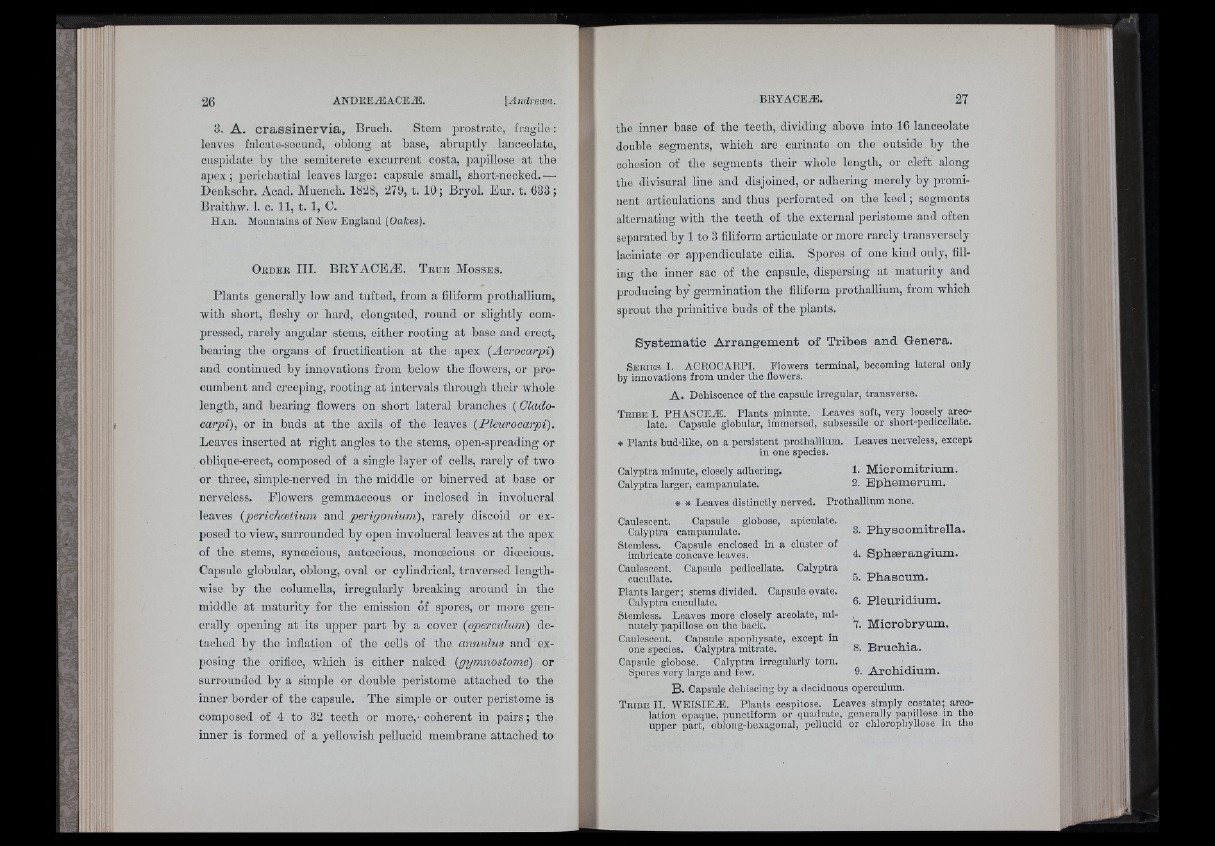
Ir *
3. A. c ra s s in e rv ia , Bruch. Stem prostrate, fragile :
leaves falcate-secuiid, oblong at base, abruptly lanceolate,
cuspidate by the semiterete excurrent costa, papillose at the
apex ; perichaBtial leaves large ; capsule small, short-necked. —
Denkschr. Acad. Muench. 1828, 279, t. 10; Bryol. Eur. t. 633;
Braithw. 1. c. 11, t. 1, C.
Hab. Mountains of New England [Oakes).
Oedek III. BRYACEAS. T eu b M o s ses .
Plants generally low and tufted, from a filiform prothallium,
with short, fleshy or hard, elongated, round or slightly compressed,
rarely angular stems, either rooting at base and erect,
bearing the organs of fructification at the apex (Acrocarpi)
and continued by innovations from below the flowers, or procumbent
and creejBing, rooting at intervals through their whole
length, and bearing flowers on short lateral branches ( Clado-
carpi), or in buds at the axils of the leaves {PUurocarpi').
Leaves inserted at right angles to the stems, open-spreading or
oblique-erect, composed of a single layer of cells, rarely of two
or three, simple-nerved in the middle or hinerved at base or
nerveless. Flowers gemmaceous or inclosed in involucral
leaves {perichmtium and perigonium), rarely discoid or exposed
to view, surrounded by open involucral leaves at the apex
of the stems, synoeoious, autoecious, moncecious or dicecious.
Capsule globular, oblong, oval or cylindrical, traversed lengthwise
by the columella, irregularly breaking around in the
middle at maturity for the emission of spores, or more generally
opening at its upper part by a cover {ppercrdum) detached
by the inflation of the cells of the annulus and exposing
the orifice, which is either naked (gymnostome) or
surrounded by a simp>le or double peristome attached to the
inner border of the capsule. The simple or outer peristome is
composed of 4 to 32 teeth or more,-coherent in pairs; the
inner is formed of a yellowish pellucid membrane attached to
the inner base of the teeth, dividing above into 16 lanceolate
double segments, which are carinate on the outside by the
cohesion of the segments their whole length, or cleft along
the divisural line and disjoined, or adhering merely by prominent
articulations and thus perforated on the keel ; segments
alternating with the teeth of the external peristome and often
separated by 1 to 3 filiform articulate or more rarely transversely
laciniate or appendiculate cilia. Spores of one kind only, filling
the inner sac of the capsule, dispersing at maturity and
producing by gei-mination the filiform prothallium, from which
sprout the primitive buds of the plants.
S y s t em a t i c A r r a n g em e n t o f T r ib e s a n d G en e r a .
Seeies I. ACROCARPI. Flowers terminal, becoming lateral only
by innovations from under the flowers.
A . Dehiscence of the capsule irregular, transverse.
Teibe I. PHASCEÆ. Plants minute. Leaves soft, very loosely areolate.
Capsiile globular, immersed, subsessile or short-pedicellate.
it Plants bud-like, on a persistent prothallium. Leaves nerveless, except
in one species.
Calyptra minute, closely adhering. 1. M i c r om i t r iu m .
Calyptra larger, campanulate. 2. B p h em e r u m .
* * Leaves distinctly nerved. Prothallium none.
Caulescent. Capsule globose, apiculate.
Calyptra campanulate.
Stemless. Capsule enclosed in a cluster of
imbricate concave leaves.
Caulescent. Capsule pedicellate. Calyptra
cucullate.
Plants larger; stems divided. Capsule ovate.
Calyptra cuculiate.
Stemless. Leaves more closely areolate, minutely
papillose on the back.
Caulescent. Capsule apopbysate, except in
one species. Calyptra mitrate.
Capsule globose. Calyptra irregularly torn.
Spores very large and few.
3. P h y s c om it r e lla .
4. S p hæ r a n g ium .
5. P h a s c um .
6. P le u r id ium .
7. M ic ro b ry um .
8. B r u o h ia .
9. A r c h id ium .
B . Capsule dehiscing by a deciduous operculum.
Tkibe II. WEISIEAl. Plants cespitose. Leaves simply costate; areolation
opaque, punctiform or quadrate, generally papillose in the
upper part, oblong-hexagonal, pellucid or chlorophyllose in the
■1 It